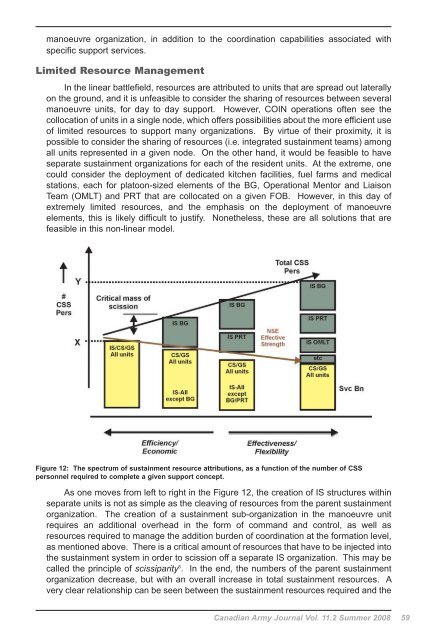Practical Sustainment Concepts for the Non-Linear Battlespace
Practical Sustainment Concepts for the Non-Linear Battlespace
Practical Sustainment Concepts for the Non-Linear Battlespace
Create successful ePaper yourself
Turn your PDF publications into a flip-book with our unique Google optimized e-Paper software.
manoeuvre organization, in addition to <strong>the</strong> coordination capabilities associated with<br />
specific support services.<br />
Limited Resource Management<br />
In <strong>the</strong> linear battlefield, resources are attributed to units that are spread out laterally<br />
on <strong>the</strong> ground, and it is unfeasible to consider <strong>the</strong> sharing of resources between several<br />
manoeuvre units, <strong>for</strong> day to day support. However, COIN operations often see <strong>the</strong><br />
collocation of units in a single node, which offers possibilities about <strong>the</strong> more efficient use<br />
of limited resources to support many organizations. By virtue of <strong>the</strong>ir proximity, it is<br />
possible to consider <strong>the</strong> sharing of resources (i.e. integrated sustainment teams) among<br />
all units represented in a given node. On <strong>the</strong> o<strong>the</strong>r hand, it would be feasible to have<br />
separate sustainment organizations <strong>for</strong> each of <strong>the</strong> resident units. At <strong>the</strong> extreme, one<br />
could consider <strong>the</strong> deployment of dedicated kitchen facilities, fuel farms and medical<br />
stations, each <strong>for</strong> platoon-sized elements of <strong>the</strong> BG, Operational Mentor and Liaison<br />
Team (OMLT) and PRT that are collocated on a given FOB. However, in this day of<br />
extremely limited resources, and <strong>the</strong> emphasis on <strong>the</strong> deployment of manoeuvre<br />
elements, this is likely difficult to justify. <strong>Non</strong>e<strong>the</strong>less, <strong>the</strong>se are all solutions that are<br />
feasible in this non-linear model.<br />
Figure 12: The spectrum of sustainment resource attributions, as a function of <strong>the</strong> number of CSS<br />
personnel required to complete a given support concept.<br />
As one moves from left to right in <strong>the</strong> Figure 12, <strong>the</strong> creation of IS structures within<br />
separate units is not as simple as <strong>the</strong> cleaving of resources from <strong>the</strong> parent sustainment<br />
organization. The creation of a sustainment sub-organization in <strong>the</strong> manoeuvre unit<br />
requires an additional overhead in <strong>the</strong> <strong>for</strong>m of command and control, as well as<br />
resources required to manage <strong>the</strong> addition burden of coordination at <strong>the</strong> <strong>for</strong>mation level,<br />
as mentioned above. There is a critical amount of resources that have to be injected into<br />
<strong>the</strong> sustainment system in order to scission off a separate IS organization. This may be<br />
called <strong>the</strong> principle of scissiparity 5 . In <strong>the</strong> end, <strong>the</strong> numbers of <strong>the</strong> parent sustainment<br />
organization decrease, but with an overall increase in total sustainment resources. A<br />
very clear relationship can be seen between <strong>the</strong> sustainment resources required and <strong>the</strong><br />
Canadian Army Journal Vol. 11.2 Summer 2008 59







![La modularite dans l'Armee de terre canadienne [pdf 1.6 MB]](https://img.yumpu.com/17197737/1/188x260/la-modularite-dans-larmee-de-terre-canadienne-pdf-16-mb.jpg?quality=85)









